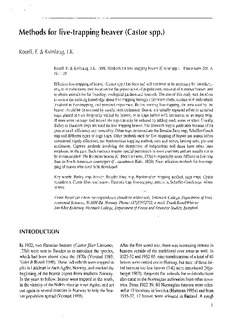| dc.description.abstract | Effective live-trapping of beaver (Castor spp.) has been and will continue to be necessary for introductions, re-introductions, translocation for the preservation of populations, removal of nuisance beaver, and to obtain animals for fur breeding, zoological gardens and research. The aim of this study was therefore to review the existing knowledge about live-trapping through a literature study, contact with individuals involved in live-trapping, and personal experience. Before starting live-trapping, the area used by the beaver should be determined by careful reconnaissance. Beaver are usually captured either in unbaited traps placed at sites frequently visited by beaver, or in traps baited with castoreum or an aspen twig. Human scent on traps and around the trap site may be reduced by adding mud, water or scent. Usually Bailey or Hancock traps are used for live-trapping beaver. The Hancock trap is preferable because of its greater catch efficiency and versatility. Other traps reviewed are the Breathe Easy trap, Scheffer-Couch trap and different types of cage traps. Other methods used for live-trapping of beaver are snares (often considered highly effective), the Byelorussian trapping method, nets and seines, landing nets, pits and enclosures. Capture methods involving the destruction of lodges/dens and dams have often been employed in the past. Such methods require special permission in most countries and are usually not to be recommended. The Eurasian beaver (C. fiber Linnaeus, 1758) is reportedly more difficult to live-trap than its North American counterpart (C. canadensis Kuhl, 1820). New, effective methods for live-trapping of beaver also need to be developed. | |
